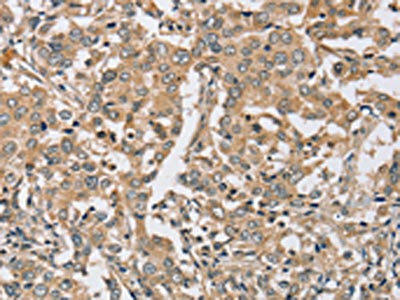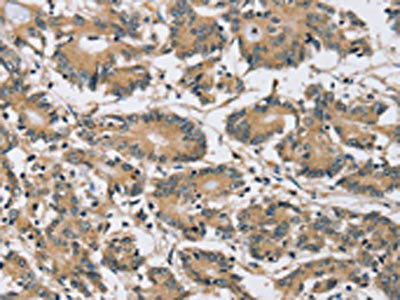Description
PDLIM7 Antibody (PACO16852)
The PDLIM7 Polyclonal Antibody (PACO16852) is a valuable tool for researchers studying the PDLIM7 gene, which is involved in various cellular processes such as cell migration and cytoskeletal organization. This antibody, raised in rabbits, is highly specific for human samples and has been validated for use in applications such as Western blotting and immunofluorescence.PDLIM7, also known as enigma homolog protein, is a scaffolding protein that plays a role in organizing signaling complexes within the cell. Its interaction with various proteins involved in signal transduction pathways makes it a key player in cell regulation and communication.
Research on PDLIM7 is crucial for understanding its role in diseases such as cancer, cardiovascular disorders, and neurological conditions.By using the PDLIM7 Polyclonal Antibody in their experiments, researchers can effectively study the expression and localization of PDLIM7 in different cell types and tissues. This antibody provides reliable and specific detection of PDLIM7, allowing for accurate analysis of its function and potential therapeutic targets.
| Antibody Name: | PDLIM7 Antibody (PACO16852) |
| Antibody SKU: | PACO16852 |
| Size: | 50ul |
| Host Species: | Rabbit |
| Tested Applications: | ELISA, IHC |
| Recommended Dilutions: | ELISA:1:1000-1:2000, IHC:1:25-1:100 |
| Species Reactivity: | Human, Mouse, Rat |
| Immunogen: | Fusion protein of human PDLIM7 |
| Form: | Liquid |
| Storage Buffer: | -20°C, pH7.4 PBS, 0.05% NaN3, 40% Glycerol |
| Purification Method: | Antigen affinity purification |
| Clonality: | Polyclonal |
| Isotype: | IgG |
| Conjugate: | Non-conjugated |
 | The image on the left is immunohistochemistry of paraffin-embedded Human liver cancer tissue using PACO16852(PDLIM7 Antibody) at dilution 1/20, on the right is treated with fusion protein. (Original magnification: x200). |
 | The image on the left is immunohistochemistry of paraffin-embedded Human colon cancer tissue using PACO16852(PDLIM7 Antibody) at dilution 1/20, on the right is treated with fusion protein. (Original magnification: x200). |
| Background: | The protein encoded by this gene is representative of a family of proteins composed of conserved PDZ and LIM domains. LIM domains are proposed to function in protein-protein recognition in a variety of contexts including gene transcription and development and in cytoskeletal interaction. The LIM domains of this protein bind to protein kinases, whereas the PDZ domain binds to actin filaments. |
| Synonyms: | PDZ and LIM domain 7 (enigma) |
| UniProt Protein Function: | PDLIM7: May function as a scaffold on which the coordinated assembly of proteins can occur. May play a role as an adapter that, via its PDZ domain, localizes LIM-binding proteins to actin filaments of both skeletal muscle and nonmuscle tissues. Involved in both of the two fundamental mechanisms of bone formation, direct bone formation e.g (embryonic flat bones mandible and cranium), and endochondral bone formation e.g (embryonic long bone development). Plays a role during fracture repair. Involved in BMP6 signaling pathway. 6 isoforms of the human protein are produced by alternative splicing. |
| UniProt Protein Details: | Protein type:Cytoskeletal Chromosomal Location of Human Ortholog: 5q35.3 Cellular Component: ruffle; focal adhesion; cytoplasm; stress fiber; nucleus; actin cytoskeleton Molecular Function:protein binding; zinc ion binding Biological Process: receptor-mediated endocytosis; positive regulation of osteoblast differentiation; ossification; multicellular organismal development; cell differentiation; actin cytoskeleton organization and biogenesis |
| NCBI Summary: | The protein encoded by this gene is representative of a family of proteins composed of conserved PDZ and LIM domains. LIM domains are proposed to function in protein-protein recognition in a variety of contexts including gene transcription and development and in cytoskeletal interaction. The LIM domains of this protein bind to protein kinases, whereas the PDZ domain binds to actin filaments. The gene product is involved in the assembly of an actin filament-associated complex essential for transmission of ret/ptc2 mitogenic signaling. The biological function is likely to be that of an adapter, with the PDZ domain localizing the LIM-binding proteins to actin filaments of both skeletal muscle and nonmuscle tissues. Alternative splicing of this gene results in multiple transcript variants. [provided by RefSeq, Jul 2008] |
| UniProt Code: | Q9NR12 |
| NCBI GenInfo Identifier: | 74752914 |
| NCBI Gene ID: | 9260 |
| NCBI Accession: | Q9NR12.1 |
| UniProt Related Accession: | Q9NR12 |
| Molecular Weight: | 50kDa |
| NCBI Full Name: | PDZ and LIM domain protein 7 |
| NCBI Synonym Full Names: | PDZ and LIM domain 7 |
| NCBI Official Symbol: | PDLIM7 |
| NCBI Official Synonym Symbols: | LMP1; LMP3 |
| NCBI Protein Information: | PDZ and LIM domain protein 7 |
| UniProt Protein Name: | PDZ and LIM domain protein 7 |
| UniProt Synonym Protein Names: | LIM mineralization protein; LMP; Protein enigma |
| Protein Family: | PDZ and LIM domain protein |
| UniProt Gene Name: | PDLIM7 |
| UniProt Entry Name: | PDLI7_HUMAN |














